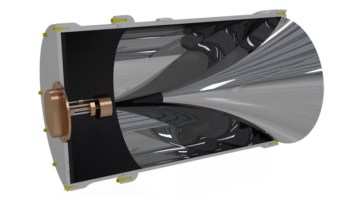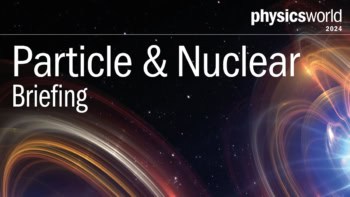
Inspired by the tetromino shapes in the classic video game Tetris, researchers in the US have designed a simple radiation detector that can monitor radioactive sources both safely and efficiently. Created by Mingda Li and colleagues at the Massachusetts Institute of Technology, the device employs a machine learning algorithm to process data, allowing it to build up accurate maps of sources using just four detector pixels.
Wherever there is a risk of radioactive materials leaking into the environment, it is critical for site managers to map out radiation sources as accurately as possible.
At first glance, there is an obvious solution to maximizing precision, while keeping costs as low as possible, explains Li. “When detecting radiation, the inclination might be to draw nearer to the source to enhance clarity. However, this contradicts the fundamental principles of radiation protection.”
For the people tasked with monitoring radiation, these principles advise that the radiation levels they expose themselves to should be kept as low as reasonably achievable.
Complex and expensive
However, since radiation can interact with intervening objects via a wide array of mechanisms, it is often both complex and expensive to map out radiation sources from reasonably safe distances.
“Thus, the crux of the matter lies in simplifying detector setups without compromising safety by minimizing proximity to radiation sources,” Li explains.
In a typical detector, radiation maps are created by monitoring intensity distribution patterns across a 10×10 array of detector pixels. The main drawback here is that radiation can approach the detector from a variety of directions and distances, making it difficult to extract useful information about the source of that radiation. This is usually done by placing an absorbing mask over the pixels, which provides some directional information, and by doing lots of data processing.
For Li’s team, the first step to reducing the complexity of this process was to minimize redundant information collected by multiple pixels within the array. “By strategically incorporating small [lead] paddings between pixels, we enhance contrast to ensure that each detector receives distinct information, even when the radioactive source is distant,” Li explains.
Machine learning
Next, the team developed machine learning algorithms to extract more accurate information regarding the direction of incoming radiation and the detector’s distance to the source.
Inspiration for the final step of the design would come from an unlikely source. In Tetris, players encounter seven unique tetrominoes, which represent every possible way that four squares can be arranged contiguously to create shapes.
By using these shapes to create detector pixel arrays, the researchers predicted they could achieve similar levels of accuracy as detectors with far larger square arrays. As Li explains, “these shapes offer superior efficiency in utilizing pixels, thereby enhancing accuracy.”.
To demonstrate this, the team designed a series of four–pixel radiation detectors, with the pixels arranged in Tetris-inspired tetromino shapes. To build up radiation maps, these arrays were moved in circular paths around the radioactive sources being studied. This allowed the detector’s algorithms to discern accurate information about source positions and directions, based on the counts received by the four pixels.
Successful field test
“Particularly noteworthy was our successful execution of a field-test at Lawrence Berkeley National Laboratory,” Li recalls. “Even when we withheld the precise source location, the machine learning algorithm could effectively localize it within real experimental data.”

BREAD experiment tracks dark photons to new levels
Li’s team is now confident that its novel approach to detector design and data processing could be useful for radiation detection. “The adoption of Tetris-like configurations not only enhances accuracy but also minimizes complexity in detector setups,” Li says. “Moreover, our successful field-test underscores the real-world applicability of our approach, paving the way for enhanced safety and efficacy in radiation monitoring.”
Based on their success, the team hopes the detector design could soon be implemented for applications including the routine monitoring of nuclear reactors, the processing of radioactive material, and the safe storage of harmful radioactive waste.
The detector is described in Nature Communications.



